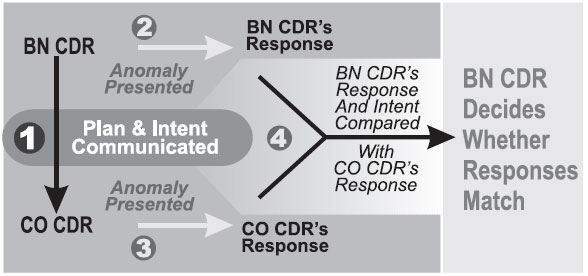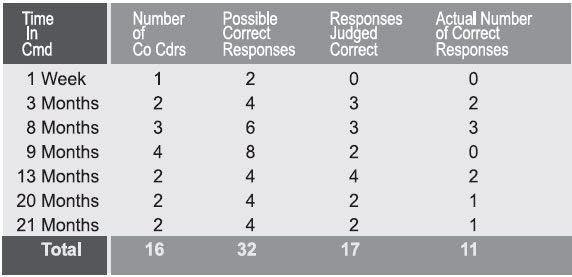|
April 13-15, 2007
Salida, Colorado
Anderson Ranch Fire — August, 1997
Investigation Report
Action Plan
Communicating Intent and Imparting Presence
Taskbook Opportunities
Salida Chamber of Commerce Visitor
Information
|
Communicating Intent
and
Imparting Presence
Lieutenant Colonel Lawrence G Shattuck, U.S. Army
An Empirical Study of
Commander’s Intent
Command and control processes are not unique to the Army, or even to
the military. Many other organizations have practices to develop plans
and procedures and then implement them at some other time and place
as the senior member of the organization desires.despite complexity
or uncertainty. But no other organization works as hard at explicitly
formulating and communicating intent to its subordinates as the US
Army. The concept of intent is written into our doctrine and taught
in our schools. Yet, as a profession, we have some work to do before
we effectively formulate, communicate, interpret and implement intent.
In an empirical study, four active duty battalions (two armor, one mechanized
infantry and one ground cavalry squadron) participated in the research.
Figure 1 describes the simulation that was used to collect data. The
battalion commanders and their operations officers knew the research
was investigating the intent process within their organizations, but
the company commanders were only told that the process was a garrison-based
exercise to provide the battalion with practice in developing operation
orders.

Figure 1. Data Collection
from battalion and company commanders.
The battalion commanders were issued a brigade operation order (OPORD)
with maps and overlays that tasked the battalion to defend in sector
and to be prepared to counterattack. The OPORD was based on an actual
NTC scenario. The battalion commanders and their staffs had one week
to develop a battalion OPORD with all appendixes and overlays. They then
disseminated the orders, which included statements of intent, to subordinate
company commanders. These company commanders (four per battalion) were
given a week to develop their own OPORDs and then briefed them back to
the battalion commanders.
An investigator reviewed copies of the battalion and company OPORDs.
Then, two situation reports (SITREPs) were created for each battalion.
In the first SITREP, the companies were blocked from completing their
specific mission but could still achieve the higher-order objectives
of the battalion commander. In the second SITREP, the companies had completed
their missions with relative ease and had to decide what to do next.
In both cases, the intent statement of the battalion commanders provided
sufficient information to help the company commanders respond to the
SITREPs.
The battalion commanders were presented with the SITREPs and asked how
they expected the subordinate company commanders to respond to each SITREP.
Their answers became the basis for evaluating the responses of their
subordinate company commanders. The SITREPs were then presented to the
company commanders. The responses of the company commanders were recorded.
The battalion commanders were shown the responses of their subordinates
and asked to judge those responses relative to their own.
Four battalions, each with four company commanders that were given two
SITREPs, generated 32 episodes. The battalion commanders judged that
the company commander’s responses matched their intent in only
17 of the 32 episodes (53 percent). In three episodes, however, the responses
matched only by coincidence—the company commanders made their decision
based not on their understanding of the battalion commander’s intent
but because they misinterpreted the information available to them. In
three other episodes, although the battalion commanders judged the decision
of the company commanders to match their own, they were, in fact, substantially
different. Battalion commanders considered them a match because the company
commanders were “thinking along the right lines.” If these
six episodes are considered mismatches, then the responses matched in
only 11of 32 episodes, or 34 percent.
Successful company
commanders that matched their battalion commander’s
intent initially determined the disposition of friendly and enemy forces.
They specifically referenced procedures and the intent statement in the
battalion OPORD. They also acknowledged that they had to coordinate their
activities with commanders of adjacent units prior to taking any action.
The amount of time the company commanders had worked for their battalion
commanders varied from as little as one week to as long as 21 months. Figure 2 summarizes
the responses of the company commanders to the SITREPs based on the length
of time they had worked for their battalion commanders.
The data do not suggest that the ability of the company commanders to
match their battalion commander’s intent was linked to the length
of time the company commanders had been in command. However, the research
did reveal several interesting patterns in the performance of subordinate
commanders.

Figure 2. Summary of
company commander responses based on their time in command.
Discussion of empirical findings. Successful company commanders that
matched their battalion commander’s intent initially determined
the disposition of friendly and enemy forces. They specifically referenced
procedures and the intent statement in the battalion OPORD. They also
acknowledged that they
had to coordinate their activities with commanders of adjacent units
prior to taking any action.
There are
four equally important components: formulation, communication, interpretation
and implementation. The first two components—formulation
and communication—are the senior commander’s responsibility.
. . . Our officer education system emphasizes formulation and students
have virtually no opportunity to practice the other three components.
Unsuccessful company commanders generally did not refer to the battalion
commander’s statement of intent. In addition, unsuccessful commanders
exhibited several other behaviors. Some commanders exhibited flawed tactical
knowledge. For example, one commander’s response to a SITREP was
to reposition his unit on the battlefield. In the scenario, however,
there was insufficient time to accomplish this maneuver. The enemy would
have attacked the company on its flank as it moved. A few commanders
had a low tolerance for situational uncertainty. They decided not to
act without more information to reduce their uncertainty. In some instances,
commanders misassessed available information. Even though they were given
information on the status of enemy units, for example, they did not incorporate
it into their mental model of the battlefield. Some commanders also exhibited
a rigid adherence to procedures despite new information that indicated
they were facing a novel, unanticipated situation. When a major, unanticipated
event occurred on an adjacent part of the battlefield, these commanders
would not deviate from their assigned mission, even though the event
jeopardized the higher-order goals of the system. Finally, the study
indicated that, in some instances, battalion and company commanders disagreed
concerning doctrinal terms. If a battalion commander and a company commander
do not have the same definition of “delay,” the subordinate
commander may make an erroneous decision.
The feedback from all four battalion commanders participating in the
study indicated that it was worthwhile and they leaned a great deal.
The results gave them a clear picture of how successfully they communicated
intent to their subordinate commanders. In addition, the results identified
areas that each unit needed to improve in formulating, communicating,
interpreting and implementing intent.
Responsibilities of senior and subordinate commanders. There are four
equally important components: formulation, communication, interpretation
and implementation. The first two components—formulation and communication—are
the senior commander’s responsibility. Subordinate commanders interpret
and implement intent. Subordinate commanders at a given echelon will
also be senior commanders and must formulate and communicate their intent
to the next lower echelon. Our officer education system emphasizes formulation.
Students at combat arms advanced courses, CAS3 , Command and General
Staff College (CGSC) and even Army War College students, practice writing
intent statements based on information provided by their instructors
(including higher commander’s intent, mission statement, information
concerning friendly and enemy forces and task organization). The final
product in these schools is usually an OPORD that is briefed to an instructor.
However, students have virtually no opportunity to practice the other
three components.
Training officers in the classroom to communicate, interpret and implement
intent is extremely difficult because these components are context-based—personality-
and situation-dependent. Interpreting and implementing intent is especially
problematic. Senior commanders formulate intent prior to hostilities,
based on their vision of the battlefield. They also communicate their
intent to subordinate commanders, who interpret it prior to hostilities.
If the battle goes according to the vision, there is no need for subordinate
commanders to refer to the intent statement. It is only when the battle
deviates from the plan that the intent statement becomes significant.
However, the context in which the intent was developed (the senior commanders’ vision)
has now changed. Subordinate commanders now must interpret and implement
the intent based on a new, probably unanticipated context. As stated
earlier, our military schools do not teach subordinate commanders to
interpret and implement intent. The results of the research reported
earlier indicate that subordinate commanders may not be learning these
skills in the field either.
<<< continue
reading—Communicating Intent and Imparting Presence, Unit Intent
Training >>>
|
